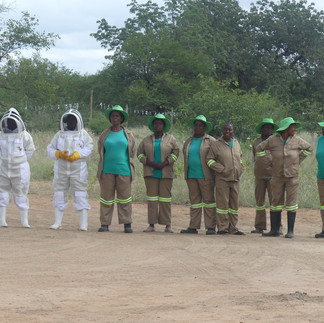Elephant Collaring with Elephants Alive on our Conservation Self Drive Adventure, Kruger National Park
- Linda Schlencker
- May 10, 2024
- 6 min read
Updated: Nov 1, 2024
Today I was brought to tears for the first time on a Self Drive Adventure. They were tears of awe brought on by an elephant collaring experience. (View the experience in the video below.)
What is Elephant Collaring?
Elephant collaring is the process of darting an elephant and while it sleeps, putting a GPS tracking collar on them. The GPS supplies tracking information to monitor their movement patterns and supplies valuable data to research teams.
How does elephant collaring work with Elephants Alive?
The day started very early, rising at 3.30am to leave at 4.30am and drive one hour from camp to meet the Elephants Alive team, Dr. Ben Muller (the veterinarian) and Gerry McDonald (skilled wildlife pilot) with Eugene Troskie offering security. There is a high degree of focus put on safety not only of those engaged in the collaring but of the animal itself. If at any stage a vet assesses that there is too much stress or danger for the animal, the collaring will not go ahead.
Elephants Alive has been using science to ensure the survival of Southern Africa's elephant population.
We then met Nduna Mabunda the local leader of the Phalaubeni community. The Hosi (King) from Hlomela community also arrived as well as two provincial representatives from the Limpopo Department of Economic Development and Tourism (LEDET) and other members of the community.
This was the third very special event involving the collaring of an elephant in the community which has a large conservancy that borders the Kruger National Park. We were able to be there as our group made a donation that was able to fund the collaring operation. We were the only people external to the community and the collaring team that were allowed to attend (see photo of donor group below).

When the helicopter arrived it set down close to the village bringing droves of the residents out to see the helicopter up close and get selfies with it. We then formed a circle for the safety brief where it was carefully explained what was to happen and how the operation would work.
One of the most critical parts of the operation is to have the elephants darted close to one of the limited number of vehicle tracks in the conservancy. It is important to ensure that the ground team can pull the elephant over with ropes if it goes down on its sternum (sternum recumbency), which can severely restrict its breathing if left unattended. If the elephant is off the track this sometimes means a high speed “bush bash” to get to the elephant ASAP to ensure its wellbeing.
We were warned to be careful while helping to push the elephant over, that the legs that then pop out from under the elephant. As the elephant can easily weigh 5-6 tones, it wouldn't take much to punch out a person standing in the way of the legs.
We were shown the collar that weighs around 10kg. Although heavy for humans it doesn’t bother the elephant other than an initial surprise to find it there. Apparently it is more the smell of human hands on it that the elephant react to initially and then it doesn’t seem to bother them beyond that.
The helicopter then went off to look for a suitable elephant either a bull or a breeding female.
We loaded up onto a safari vehicle or into our own cars and drove into the conservancy being directed by radio from the helicopter.
They located a suitable male, Elephants Alive then confirmed the operation was live and the bull was darted.
Gerry the amazing wildlife pilot was able to gently herd the groggy bull towards the road. As he started to go down Eugene called that he thought he was falling forward onto his sternum so it was out of the cars quickly and we raced into the bush, Dr. Michelle Henley (CEO of Elephants Alive) running with the heavy collar which she seemed to manage to get around his neck before he was pushed onto his side - his huge legs kicking out as they had told us to be careful of.
hen all sorts of things happen that we were able to get involved in. Measurement of leg size, trunk size, the collection of blood and hair samples just to name a few as the collar was secured and activated. The bull was snoring loudly throughout the whole process. It is a sound I shall never forget. Turn up your sound for the video below - AMAZING!
The underside of his ear was sprayed with water to evaporate and keep him cool as Ben (the vet) shared some fascinating physiological facts about the bull with us.
The sleeping giant was a prime elephant bull of breeding age, around 5-6 tonnes and around 35 years old. He was “right handed” which you could tell by the callouses on the trunk which side the used more often and from the working groove in the tusk. Ben showed us the inside the elephant's mouth, the molars and the Jacobson's organ through which the elephants do all their smelling and hormone assessment of other elephants. There was a small twig put inside the end of the trunk to keep the trunk airway open while the delightful snoring blared on throughout the explanation. We were able to touch the elephant and have photos taken with him. Other than the rough thick hair, the skin is quite soft (and dirty).
How do you name an elephant?
We had about 30 minutes with him. During this time I asked the village leader what he was going to name him. After some deliberation Induna Mabunda and Nkosi Hlomela agreed on Mantsena (Remembrance). This will be the name of “our elephant” when we get the tracking link to follow his movements.
We found out that Mantsensa was a known crop raider that brought other younger males with him, so he is an excellent one to have collared so Elephants Alive can alert the community and they can have their “deterrent team” in place to scared off the elephants when they turn up to crops.
After all the work that needed to be done was complete, a "wake up" shot was administered and we all stood well back at the vehicles and watched Mantsena awake and feel his new collar.
What type of food do elephants like and dislike?
“Bees, Trees, Elephants and People” are the strapline for the many research activities of Elephants Alive.
We met the tree or vegetation monitoring expert of Elephants Alive, Dr. Robin Cook, who explained the research he had done on elephants and Marula trees. Elephants love the fruit of these trees. When Elephants Alive protected the trees by putting native bee hives in the trees, they had a 85% success rate of deterring the elephants. This is because the bees swarm and attack the eyes of the elephants. Michelle an her team had also experimented with setting up an “elephant cafeteria experiment” with all types of crops to determine elephant's likes and dislikes.
The cafeteria style experiments main purpose was to test which known essential oil plants are unpalatable to elephants. These can then be grown to protect crops and provide communities with an income. At the community site we visited after the collaring operation, elephants disliked lemon grass, chilli and other aromatic plants that had been tested. The unpalatable crops are then planted around the border of the food crops.
We also saw a bee-hive fence in action. The bee hives are attached to wire so that if the elephant pushes against the wire to enter the perimeter, the hive is disturbed and the bees swam to sting the elephants.
Other crop-protection methods we were told about included the manufacturing of smelly elephant repellent which involves foul smelling brews of fermented cattle dung mixed with with ginger, garlic, eggs and chilli that can be sprayed directly onto the food crops (washed off just before consumption) or put in bottles around the crops. Chilli can also be smeared onto fabric and placed on fences to make a chilli-rag fence or shiny pieces of metal that rattle in the breeze and reflect of solar powered flashing lights are also effective at night (when elephants sneakily do most of their crop-raiding).
Most of these techniques have been learned from other parts of Africa like Kenya, Uganda and Tanzania. With the help of Elephants Alive these techniques are all being used at the village we visited and we were able to see their protected food garden in practice.
15 households farmed their plot, supporting 109 people in total. Elephants Alive have not only been protecting their crops but also helped fix their borehole and lay irrigation pipes for them to water the palatable and unpalatable plants more effectively. The ladies welcomed the group with a song of thanks and showed us around and they treated us to freshly cooked beans and sweet potatoes.
What an amazing experience! Conservation is a complex issue and today was certainly an inspiring insight into work that is being carried out by dedicated and passionate people in Africa. We cannot thank enough Elephants Alive and Wild Wonderful World for pulling together the myriad the complicated logistics that allowed us to be involved in this project. It is an experience I shall never forget.
Find out more about our African Self Drive Adventures experiences on our website.























































Comments